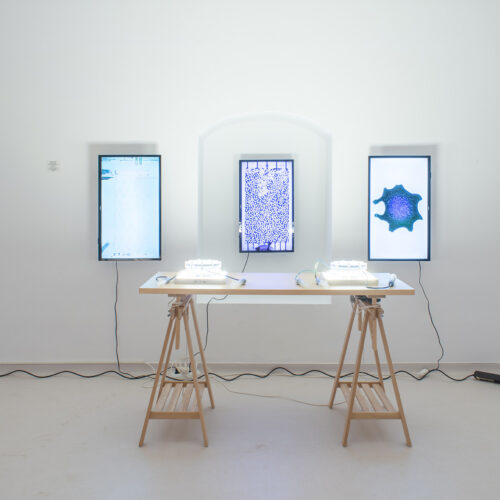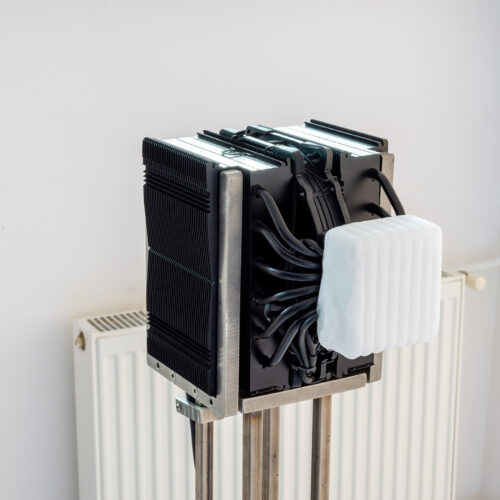The exhibition POROUS MATTER. Void Fractions in Materials, Ideas, and Society, opened this autumn at META Spațiu in Timișoara, in the context of the European Capital of Culture, is the result of an interdisciplinary research involving four artists from Romania and Norway – Floriama Cândea, Maria Castellanos, Cosmin Haiaș, Stahl Stenslie, and four scientists – Florin Drăgan (UPT), Alex Hansen (Porelab), Liviu Marșavina (UPT), Marcel Moura (Porelab). The partnership involving three collaborating universities and a curatorial team composed of Mirela Stoeac-Vlăduți (curator) and Loredana Nedelcu (assistant curator) started as early as 2022 with laboratory visits to Romania and Norway, unique scientific experiments, working sessions and debates.
The concept around which the entire project is built is that of porous matter, with the emphasis on how notions of fluid mechanics, such as void fractions, porosity, flow, encompass both the biological world and the world of ideas or social machinery. Porosity as a measure of the vacuum, of the relationship between the empty and the full, thus proves to be a fundamental relation between the paradigms of art, nature and society. It is a means of comprehending the mechanics of life and communication as well as a way of deciphering the connections of all the above with the apparently independent phenomenon of aesthetics.
Biology tells us that the most porous human organ is the brain itself. Phenomenology equates man with nothingness, with a mere pore of the world, with the opening in which things come one by one and reveal themselves, illuminate themselves in order to be understood. Just as in aesthetics it has been argued that the Grand Theory of beauty as proportion and visible harmony is only a surface effect of a deeper harmony of intelligible beauty, the meaning of porosity must be sought somewhere at the root of the world, where the number becomes sacred, the metaphysical nothingness proves to be the true measure of Being, art penetrates life and biology, and science becomes charged with harmonies and iridescence.
In this context, the artists and scientists involved in the POROUS MATTER project are pursuing the poetry hidden in scientific representations, laboratory experiments and instrumentation, as well as the resemblances shared between fluid flow and data streams. Stahl Stenslie thus exposes, in the work Fluid processor for ecological computing, digital representations of the principles of porous media and flow revealed in the laboratories of the Polytechnic University of Timișoara together with Florin Drăgan. It is primarily a transparent, 3D-printed cube that encases a porous sphere and is a prototype of the liquid computing programming model, in which tasks flow from one device to another following the principles of nature. Secondly, the work involves a print, a map whose circular territories trace in shades of blue the flow of fluids in a porous material but also the rhythms and imperfections of human communication and harmony. The resemblance between this map and the concentric layout of a musical score reminds us that Pythagoras himself invented the Grand Theory inspired not by visible proportions but by subtle harmonies of sound.
The same deep, astral blue reappears in Floriama Cândea’s fascinating installation, Internal flow Studies, on display nearby. The artist creates a kinetic project in which fluid guided by an Arduino controller flows through a series of tubes whose configuration simulates the human circulatory system, the flow of plant sap and, last but not least, the image of the world as a whole in the form of a highway of connection and communication. The invisible becomes visible, revealing the existence of a common principle at the root of the world where human plant-becoming takes place and where leaves exhibit their own venous system. The three highways circulated by blue fluid and air bring back into question the dichotomies of full-empty, object-space, inspiration-expiration, but also the architecture of the digital based on strings of bits: 1 and 0. The intermedial poetry is enhanced by the presence of a small analog projection on the wall, a zoom on the flow produced by a device that mixes the features of an overhead projector with those of a microscope.
Blue also infuses the works of physicist Marcel Moura, Porous Hypnosis 1 and All roads have porous, convinced by curator Mirela Stoeac-Vlăduți to exhibit for the first time. The brave physicist thus transforms his laboratory experiments on fluid mechanics and on the way liquids and gasses move within a porous network into an interactive art installation. A series of projections and translucent 3D-printed porous structures allow an insight into the process of water seeping into the ground during rainfall and the movement of fluids within rocks. The process can be controlled by the public using a system of syringes that, like musical instruments, define the rhythm of the flow.
The presence of beauty is thus revealed at levels beyond the sensitive, the phenomena, the mere visual art, its truth and brilliance are brought out of hiding, the instruments and the laboratory itself are lifted from the primacy of the functional. The transcendence of the visible is also put into action by Light Structure Experiment, a sound and light performance conducted on the evening of the opening by Bogdan Scoromide, an artist active in the fields of sound experiments and audio tapes, and by Sergiu Doroftei, a multimedia artist specialized in kinetic installations, light and soundscapes.
A delicate but very powerful piece that mediates between the territories of art and science, between the real and the virtual, between the natural world and the digital world is Cyborg Placenta, a study initiated by María Castellanos on the properties and function of the mysterious and spongy organ of the placenta. The placenta is unquestionably a porous environment, an organ with bi-directional cellular traffic that connects the foetus to the mother, filtering both nutrients and oxygen for the foetus, as well the residual substances produced by the latter or bi-directionally sent hormones. Although it is a vital organ containing stem cells, the placenta is at the same time a transient extracorporeal organ that develops invasively in the woman’s uterus, only to disappears immediately after birth.
In the work in question, which involves both a projection and a circular laboratory object in which an isolated placenta pulsates, the artist evokes science-fiction visions in which the future of this organ hovers somewhere between the freedom and autonomy conferred by a body without organs and the dystopian vision of biopower, monitoring and cloning. The possibility of the placenta surviving after birth and detaching from the woman’s body, its ability to store and use stem cells for personalised therapies and the recent worrying findings about the high levels of microplastic found in women’s placentas (50%, study in Haiti, 2023), are all called into question.
A project of great media and conceptual complexity that follows posthuman critical premises is the one proposed by Cosmin Hăiaș, an iconic artist of the media scene in Timișoara and a long-time collaborator of Meta Spațiu. An initial work, ironically titled H111 – unFortune Cookies, is an anthropomorphic interactive installation whose robotic head captures CO2 from the breath of individuals who get close enough. Although at first glance this soft-robotic humanoid with its plastic head and malleable silicone limbs seems an inert presence, it paradoxically comes to life with the first whiff of human exhaled CO2, arching its silicone fingers into floral shapes and ultimately unleashing ironic dystopian ravings that reveal the future crises of the Anthropocene, the impossibility of the future, the darkness rooted in our collective anxiety. The throbbing of silicone limbs conveys movement further down the work, where a translucent white fetal form begins to breathe faintly. The fetal form initiates multiple connections, both to María Castellanos’s Cyborg Placenta and to another of Haiaș’s works, I see nothing, a virtual fetus with cold neon skin and machine vision that is part of the permanent exhibition of Meta Gallery.
Under the same environmentalist framework that criticizes the present context of global warming as well as the irreversible degradation of nature and dwellings, Hăiaș’s latest installation, ICE, is a simple and ingenious device that produces snow at room temperature. Faced with a bleak future ICE reminds us that what is now a simple ice cube has the potential to become a precious exhibit in the museums of the world, a relic of the future itself on the verge of extinction.
Thanks to his hybrid background as an engineer and artist, interested in nature, in the intrinsic mechanisms of language and in generating authentic links between the human and the non-human, Cosmin Hăiaș is a symbol of the whole Porous Matter project and collective and, more broadly, of the collaborative, interdisciplinary and transmedial working practice of Meta Spațiu. We acknowledge that this space of genuine convergence between art, science and technology, which invokes historical collaborations such as Experiments in Art and Technology, has become, thanks to the efforts of curator and director Mirela Stoeac-Vlăduți, perfectly engaged internationally as well as being unparalleled on the Romanian media scene, where such experiments are usually singular or only simulated.
Translated by de Dragos Dogioiu
*This journalistic material was produced with funding from Energie! Creation Grants, awarded by the Municipality of Timișoara, through the Project Centre, within the national cultural program “Timișoara – European Capital of Culture in 2023”.
The material does not necessarily represent the position of the Timișoara City Project Centre and the Centre is not responsible for its content or how it may be used.
POSTED BY
Raluca Oancea
Raluca Oancea (Nestor), member of International Association of Art Critics (AICA) and European Network for Cinema and Media Studies (NECS), is a lecturer at The National University of Arts in Buchares...
www.Dplatform.ro































Comments are closed here.